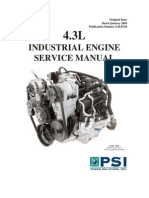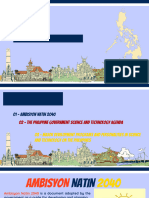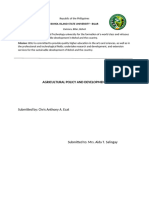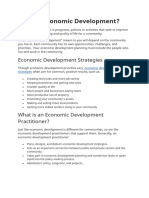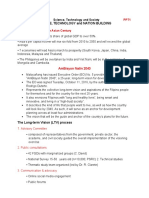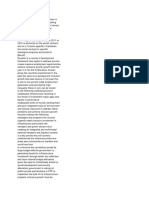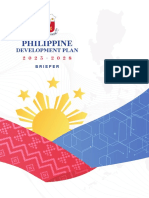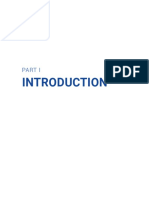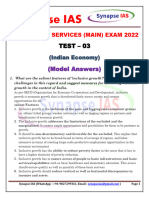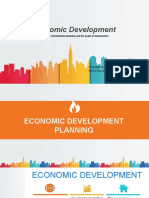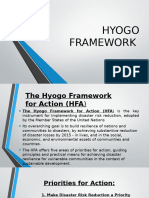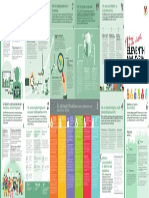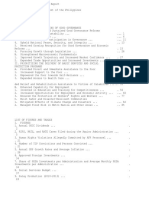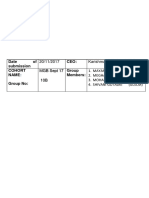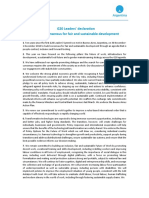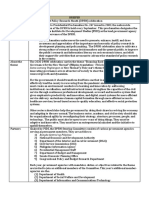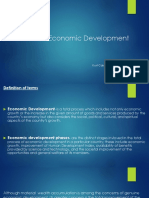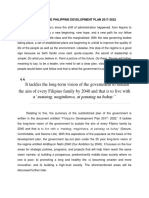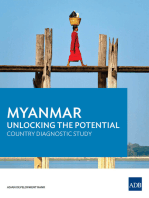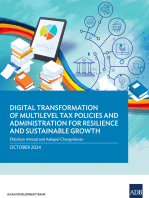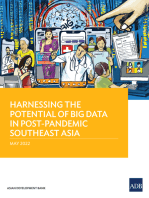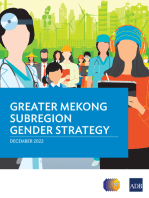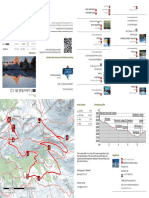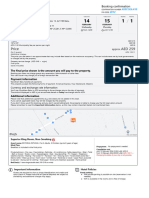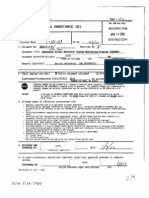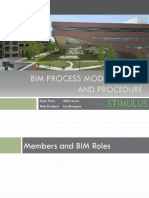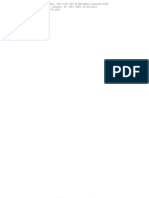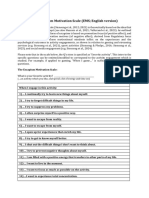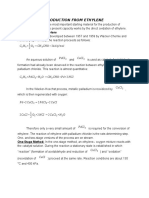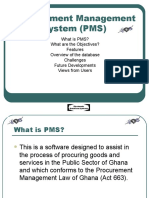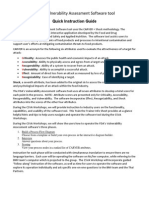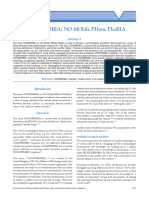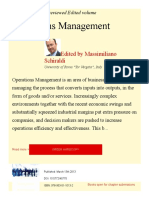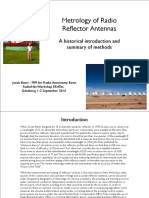City Development Strategy
City Development Strategy
Uploaded by
Plinky AgumCopyright:
Available Formats
City Development Strategy
City Development Strategy
Uploaded by
Plinky AgumOriginal Title
Copyright
Available Formats
Share this document
Did you find this document useful?
Is this content inappropriate?
Copyright:
Available Formats
City Development Strategy
City Development Strategy
Uploaded by
Plinky AgumCopyright:
Available Formats
CITY DEVELOPMENT STRATEGY
The city’s role as an engine of economic growth has become more important as the world becomes increasingly urbanized. It
is critical for cities to be strategic about their investments and growth in order to capitalize on opportunities.
A City Development Strategy is a tool that helps a city harness the potential of urbanization. It also enables a city to
develop a coordinated, institutional framework to make the most of opportunities. And, perhaps most importantly, a CDS gives
residents a chance to have a voice in the future of the place where they live.
The Cities Alliance supports cities in preparing city development strategies that link their economic growth and poverty
reduction objectives, often including citywide slum upgrading strategies.
Sustainable Urbanization
URBANIZATION – refers to the population shift from rural to urban residency, the gradual increase in the proportion of people living
in urban areas, and the ways in which each society adapts to this change. It is predominantly the process by which towns and cities
are formed and become larger as more people begin living and working in central areas.
A process that balances among economic, environmental and social perspective on urban area is prominently known as
“Sustainable urbanization”. There is an expert system required to create this balance. Alternatively, to balance various aspects,
urban planning is a conventional tool adapted. To achieve sustainability, urban planning has a key role in providing the balance. In
significantly represented portion of developing countries, City Development Strategies (CDS) is an emerging strategic urban
planning approach to maintain sustainability. This achievement varies at different level based on various definitions of CDS. By
choosing some specific definitions of CDS by international agencies, this paper studies and compares the accomplishment.
Philippine Development Plan 2017-2022 Overall Framework
We are building a future where every Filipino enjoys a matatag, maginhawa, at panatag na buhay. Just like any building
construction, we begin by laying down a strong foundation for more inclusive growth, a high-trust and resilient society, and a globally-
competitive knowledge economy. The impact will be manifested in the following outcomes:
• The Philippines will be an upper middle-income country by 2022.
• Growth will be more inclusive as manifested by a lower poverty incidence in rural areas – from 30 percent in 2015 to 20
percent in 2022.
• The Philippines will have a high level of human development by 2022.
• The unemployment rate will decline from 5.5 percent to 3-5 percent in 2022.
• There will be greater trust in government and in society.
• Individuals and communities will be more resilient.
• Filipinos will have greater drive for innovation. These foundational outcomes should be able to support the succeeding
medium term plans, all the way to 2040 and beyond.
Strategic Outcomes
A matatag, maginhawa, at panatag na buhay by 2040 will be achieved if we are able to lay down the foundation for inclusive
growth, a high-trust and resilient society, and a globally-competitive knowledge economy by 2022. This goal will be supported by three
pillars - Malasakit, Pagbabago, and Patuloy na Pag-unlad - which are further supported by strategic policies and macroeconomic
fundamentals, and built on a solid bedrock of safety, peace and security, infrastructure, and a healthy environment.
The major strategic outcomes are the following:
Pillar 1: Enhancing the social fabric (Malasakit): There will be greater trust in public institutions and across all of society.
Government will be people-centered, clean, and efficient. Administration of justice will be swift and fair. There will be greater
awareness about and respect for the diversity of our cultures.
Pillar 2: Inequality-reducing transformation (Pagbabago): There will be greater economic opportunities, coming from the
domestic market and the rest of the world. Access to these opportunities will be made easier. Special attention will be given to the
disadvantaged subsectors and people groups.
Pillar 3: Increasing growth potential (Patuloy na Pag-unlad): Many more will adopt modern technology, especially for
production. Innovation will be further encouraged, especially in keeping with the harmonized research and development agenda. And in
order to accelerate economic growth even more in the succeeding Plan periods, interventions to manage population growth will be
implemented and investments for human capital development will be increased.
Enabling and supportive economic environment: There will be macroeconomic stability, supported by strategic trade
and fiscal policies. A strong and credible competition policy will level the playing field and encourage more investments.
In the Philippines, the statistics essential for CDS Frameworks may be taken from selected departments of the
national government, such as:
1. Department of Trade and Industry (DTI) and its bureaus and agencies
• For product and service standards.
• Consumer Protection Guidelines.
• Incentive Programs.
• Export – Import Statistics.
• Other Trade Data.
2. Department of Labor and Employment (DOLE) and its bureaus and agencies
• For manpower availability.
• Skills Development.
• Wage and Benefits.
• Employer – Employee Rights.
3. Department of Interior and Local Government (DILG) and its bureaus and agencies
• Regional, Provincial and Local Development Plan.
4. Department of Public Works and Highways (DPWH) and its bureaus and agencies
• For Infrastructure Development.
5. Department of Education (DepEd) and its bureaus and agencies
• For Basic Education, Skills Training and Development.
6. Commission on Higher Education (CHED) and Technical Skills and Development Authority (TESDA) and its
bureaus and programs
• Provide higher education and technical-vocational skills training and development.
7. Department of Health (DOH) and its bureaus and agencies
• For Employee Health Certificates, Product Registrations, and License to Operate.
Food and Drug Administration (FDA) - monitor, and regulate the flow of food, drugs, cosmetics, medical devices,
and household hazardous waste in the Philippines.
COMPETITIVE ENVIRONMENT
PORTER MODEL -
www.citiesalliance.org/cds
www.neda.gov.ph/tag/philippine-development-plan-2017-2022
You might also like
- C5 Config BSIDocument31 pagesC5 Config BSImarkmark5678% (9)
- Active, Reactive Apparent Power Assignment Student Template Fall 2020Document8 pagesActive, Reactive Apparent Power Assignment Student Template Fall 2020GabrielGreco100% (1)
- Strategic and Operational PlanningDocument5 pagesStrategic and Operational Planningangie lloyd saligan100% (1)
- Programs - Projects For Philippine Socio - Economic DevelopmentDocument7 pagesPrograms - Projects For Philippine Socio - Economic Developmentdjm070376100% (1)
- The Philippine Development Plan Reaction PaperDocument10 pagesThe Philippine Development Plan Reaction PaperJoanna Canlubo Jamito83% (6)
- Philippine Administrative ReformsDocument58 pagesPhilippine Administrative ReformsMarvin Cabantac100% (2)
- SDGs Questions and Answers PDFDocument7 pagesSDGs Questions and Answers PDFjohnson ndabaNo ratings yet
- Wender Utah Rating Scale For The Attention Deficit Hyperactivity DisorderDocument2 pagesWender Utah Rating Scale For The Attention Deficit Hyperactivity DisorderUnoduetre StellaNo ratings yet
- GM 4.3L Manual DesarmeDocument0 pagesGM 4.3L Manual DesarmeLuis Carlos Acosta100% (1)
- PDP 2017-2022 PDFDocument62 pagesPDP 2017-2022 PDFGeorgie IbabaoNo ratings yet
- Regional Development Plan CAR 2017-2022 Chapter 1Document6 pagesRegional Development Plan CAR 2017-2022 Chapter 1Andrew EvangelistaNo ratings yet
- Week-5-6_Science-Technology-and-Nation-BuildingDocument62 pagesWeek-5-6_Science-Technology-and-Nation-Buildingsiponofficial110No ratings yet
- Development AdministrationDocument28 pagesDevelopment AdministrationKeshab PandeyNo ratings yet
- Philippine Development Plan (PDP) 2017-2022: (Critique Paper)Document36 pagesPhilippine Development Plan (PDP) 2017-2022: (Critique Paper)Third YearNo ratings yet
- National Strategy For Financial Inclusion: BackgroundDocument4 pagesNational Strategy For Financial Inclusion: BackgroundcpvinculadoNo ratings yet
- EC366Document114 pagesEC366Claire ManyangaNo ratings yet
- Unit 5 Development Programs For MSMEs by NEDADocument11 pagesUnit 5 Development Programs For MSMEs by NEDARena Mae BalmesNo ratings yet
- Updated Philippine Housing Socio - Economic Goals.Document8 pagesUpdated Philippine Housing Socio - Economic Goals.Christian VinluanNo ratings yet
- Agri3 - CHRIS ANTHONY ECATDocument24 pagesAgri3 - CHRIS ANTHONY ECATCamela Rose CabahugNo ratings yet
- Programs-Projects For Philippine Socio Economic DevelopmentDocument27 pagesPrograms-Projects For Philippine Socio Economic Developmentdjm070376100% (2)
- Economic DevelopmentDocument5 pagesEconomic Developmenttyagikartik1919No ratings yet
- PDP 2023 2028 Briefer 1Document13 pagesPDP 2023 2028 Briefer 1Joshua Gonzales CorpuzNo ratings yet
- Review-and-Future-TrendsDocument3 pagesReview-and-Future-TrendskenivanabejuelaNo ratings yet
- STS Reviewer 1Document7 pagesSTS Reviewer 1Kristine Joy Paguyo UlitNo ratings yet
- PDP AquinoDocument5 pagesPDP Aquinorfactor0976No ratings yet
- PDP 2017-2022 Pre-publication-copy-UpdatedDocument332 pagesPDP 2017-2022 Pre-publication-copy-UpdatedMelitus NaciusNo ratings yet
- NEDA, (2018) - PDP - 20210310 Pre Publication Copy Updated Philippine Development Plan 2017 2022 - RevDocument341 pagesNEDA, (2018) - PDP - 20210310 Pre Publication Copy Updated Philippine Development Plan 2017 2022 - RevArch Sylvester Seno MArch-ctmNo ratings yet
- Republic of The Philippines Sorsogon State College Sorsogon City Campus Sorsogon CityDocument9 pagesRepublic of The Philippines Sorsogon State College Sorsogon City Campus Sorsogon CityJhon dave Surbano100% (1)
- PDP 2023 2028 BrieferDocument10 pagesPDP 2023 2028 BrieferKanra Mendoza100% (1)
- Chapter 01Document18 pagesChapter 01Karl King EsmeraldaNo ratings yet
- Test-03 Indian Economy Model AnswerDocument17 pagesTest-03 Indian Economy Model AnswerChiranjeev RoutrayNo ratings yet
- Economic Development: Prepared By: Liezle Precious R. Estrada Maed Social StudiesDocument20 pagesEconomic Development: Prepared By: Liezle Precious R. Estrada Maed Social Studiesliezle estradaNo ratings yet
- HYOGO-FRAMEWORKDocument9 pagesHYOGO-FRAMEWORKnadine albalosNo ratings yet
- Phil Devt Plan 2017 - 2022Document29 pagesPhil Devt Plan 2017 - 2022Zheerica Ella Del CarmenNo ratings yet
- Socio-Economic Development: Definition Nature and Content of SocioDocument53 pagesSocio-Economic Development: Definition Nature and Content of SocioChristela TorretaNo ratings yet
- 10 Socio-Economic Agenda - PPTX APP ECONDocument13 pages10 Socio-Economic Agenda - PPTX APP ECONLarisha Frixie M. DanlagNo ratings yet
- Overview of Botswana'S Development Strategy/Plan: National Workshop On The Vienna Programme of ActionDocument26 pagesOverview of Botswana'S Development Strategy/Plan: National Workshop On The Vienna Programme of ActionDidier D. Boko-hayaNo ratings yet
- Rmk11 11mp Brochure BiDocument2 pagesRmk11 11mp Brochure BiZulkifli Zainal RampakNo ratings yet
- Urban PLanning NotesDocument22 pagesUrban PLanning NotesCarlo CapiliNo ratings yet
- Reference B - 8-Point Socioeconomic AgendaDocument6 pagesReference B - 8-Point Socioeconomic AgendaLimuel Richa Paghubasan TrangiaNo ratings yet
- Philippine Development Plan 2011-2016Document400 pagesPhilippine Development Plan 2011-2016Carl86% (14)
- SONA Technical Report PDFDocument116 pagesSONA Technical Report PDFTin RamosNo ratings yet
- Giga..sbr 1Document8 pagesGiga..sbr 1Karishma AilsinghaniNo ratings yet
- Documento G20Document8 pagesDocumento G20EL DESTAPENo ratings yet
- Buenos Aires Leaders DeclarationDocument40 pagesBuenos Aires Leaders DeclarationMelina RodríguezNo ratings yet
- Sodoso Activity-Task2 NSG133Document2 pagesSodoso Activity-Task2 NSG133Wench Ryechelle SodosoNo ratings yet
- PDP Chapter 7: CultureDocument18 pagesPDP Chapter 7: CultureEdriane BandaviaNo ratings yet
- What Is Regional DevelopmentDocument12 pagesWhat Is Regional DevelopmentBuddhikaNo ratings yet
- Briefer - DPRM 2020 - Innovating GovernanceDocument3 pagesBriefer - DPRM 2020 - Innovating GovernanceMis M EstoperesNo ratings yet
- PDP 2017-2022Document297 pagesPDP 2017-2022Vince LeidoNo ratings yet
- Phases of Economic DevelopmentDocument15 pagesPhases of Economic DevelopmentMarlene Agcaoili100% (2)
- Philippines Development Plan 2017-2022 ReviewDocument9 pagesPhilippines Development Plan 2017-2022 ReviewLucymarie Capistrano100% (7)
- STS ReportingDocument6 pagesSTS ReportingclarencemvpgarsulaNo ratings yet
- Cep NoteDocument6 pagesCep Notesorianojayem2100% (1)
- Strengthening Domestic Resource Mobilization in Southeast AsiaFrom EverandStrengthening Domestic Resource Mobilization in Southeast AsiaNo ratings yet
- The Philippines Country Knowledge Strategy and Plan, 2012–2017: A Knowledge CompendiumFrom EverandThe Philippines Country Knowledge Strategy and Plan, 2012–2017: A Knowledge CompendiumNo ratings yet
- Inclusive Green Growth Index: A New Benchmark for Quality of GrowthFrom EverandInclusive Green Growth Index: A New Benchmark for Quality of GrowthNo ratings yet
- Fiji: Building Inclusive Institutions for Sustained GrowthFrom EverandFiji: Building Inclusive Institutions for Sustained GrowthNo ratings yet
- : Digital Transformation of Multilevel Tax Policies and Administration for Resilience and Sustainable GrowthFrom Everand: Digital Transformation of Multilevel Tax Policies and Administration for Resilience and Sustainable GrowthNo ratings yet
- Harnessing the Potential of Big Data in Post-Pandemic Southeast AsiaFrom EverandHarnessing the Potential of Big Data in Post-Pandemic Southeast AsiaNo ratings yet
- Be Tut For FeDocument49 pagesBe Tut For Felishan wongNo ratings yet
- En 5 Lakes Walk Nr. 11Document1 pageEn 5 Lakes Walk Nr. 11HeidiNo ratings yet
- Wyndham For PeopleDocument2 pagesWyndham For PeopleAnfas VNo ratings yet
- Extended Reach DrillingDocument3 pagesExtended Reach DrillingLoganBohannonNo ratings yet
- Global Ev Out Look 2017Document71 pagesGlobal Ev Out Look 2017Fred Lamert100% (2)
- Dr. Ayush Srivastava Dr. A. P. J. Abdul Kalam Technical University Assistant Registrar Uttar Pradesh, Lucknow Nodal Officer-Training & PlacementDocument3 pagesDr. Ayush Srivastava Dr. A. P. J. Abdul Kalam Technical University Assistant Registrar Uttar Pradesh, Lucknow Nodal Officer-Training & PlacementNaman MishraNo ratings yet
- ML11241A211 - Emergency Diesel Generator Engine Monitoring Program (EDGEMP)Document18 pagesML11241A211 - Emergency Diesel Generator Engine Monitoring Program (EDGEMP)EnformableNo ratings yet
- Schedule Alat Dan Man PowerDocument3 pagesSchedule Alat Dan Man PowerBagas Lesta CoratiesNo ratings yet
- BIM Ex PlanDocument40 pagesBIM Ex Plancoidoianh100% (1)
- M BMTDocument20 pagesM BMTNORBELYSNo ratings yet
- Peugot 206 2001 2.0HDi FusesDocument8 pagesPeugot 206 2001 2.0HDi FusesKevin HarperNo ratings yet
- 6 BBS Reading Material by DR HL KailaDocument55 pages6 BBS Reading Material by DR HL KailaSuman DuttaNo ratings yet
- AAC-018 The Problem of Bogus PartsDocument7 pagesAAC-018 The Problem of Bogus PartsIsrael UgaldeNo ratings yet
- TheEscapismMotivationScale ENG 22014Document3 pagesTheEscapismMotivationScale ENG 22014Farzana AfzalNo ratings yet
- Oxidation of Ethylene (Production)Document4 pagesOxidation of Ethylene (Production)Alperen AydınNo ratings yet
- Procurement Management System (PMS)Document15 pagesProcurement Management System (PMS)Shweta GambhirNo ratings yet
- FDA Vulnerability Assessment Tool Quick Instruction GuideDocument6 pagesFDA Vulnerability Assessment Tool Quick Instruction Guideasanchezt100% (1)
- University of Santa Monica HomeworkDocument8 pagesUniversity of Santa Monica Homeworkafnahsypzmbuhq100% (1)
- ChecklistDocument4 pagesChecklisttestphisNo ratings yet
- Ajp Practical AnswersDocument6 pagesAjp Practical AnswersITsai KondaNo ratings yet
- Research - NomophobiaDocument4 pagesResearch - Nomophobiachristy.white07No ratings yet
- Siemens Mcbs CatalogueDocument11 pagesSiemens Mcbs CatalogueSACHIN CHAVANNo ratings yet
- 5000 Series: User'S ManualDocument122 pages5000 Series: User'S ManualAndres GarciaNo ratings yet
- Administracion de Operaciones - CompletoDocument246 pagesAdministracion de Operaciones - CompletojhlaravNo ratings yet
- Jaap Baars Metrol-Goth-PublDocument29 pagesJaap Baars Metrol-Goth-PublMichael DudekNo ratings yet
- Share Go Director Raftaar Training Module Jan 2023Document64 pagesShare Go Director Raftaar Training Module Jan 2023Shravan Khilledar100% (1)








